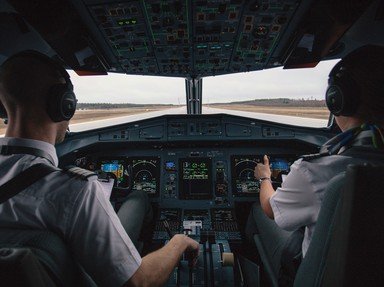Quiz Answer Key and Fun Facts
1. Kyle the Kennel Boy gazed out of the window of a now near-vintage aircraft as it sat on the tarmac at Belfast City Airport. He could see two giant yellow cranes and behind them a low building where, in all probability, the aircraft had been built. Which aircraft company was long associated with Northern Ireland?
2. "Oh, isn't it flat", thought Kyle the Kennel Boy as his plane from Belfast touched down in The Netherlands.
"This could be Rotterdam or anywhere/Liverpool or Rome/'Cause Rotterdam is anywhere/Anywhere alone" he sang to himself while eyeing up the next aircraft on his itinerary. What was this Dutch-made aircraft?
3. Flying out of Rotterdam, Kyle the Kennel Boy was very impressed with the luxury of the high-end Falcon business jet he was onboard. Which French company made the Falcon?
4. Back in WWI, there was lot of debate about the merits of 'pusher' aeroplanes and 'tractor' aeroplanes, Kyle the Kennel Boy read while in Rome. He was about to board one of the few twin-pusher turboprops on the market. Which company made the P180 Avanti?
5. Sometimes a window seat in an aircraft can be an unfortunate choice, thought Kyle the Kennel Boy as the wingtips of his plane seemed to brush the Alpine mountainsides as it landed into Innsbruck. Kyle was in Austria, aboard an aircraft by a company that had started life making motor gliders. Which of these became a later aircraft designation of the company?
6. Here we go again thought Kyle the Kennel Boy as he looked down on the Alps on a flight to Switzerland. Typically noted for chocolate, cheese, and cuckoo clocks, what was the name of the largest Swiss-based aircraft company?
7. Did you know that vikings did not actually have horns on their helmets? Kyle the Kennel Boy did not until he read it in the in-flight magazine in an aircraft taking carrying him Stockholm. That plane had been built locally. Which company also associated with motor cars had manufactured it?
8. Landing back in Geneva and after a frantic dash from the Swiss side to the French side of the airport, Kyle The Kennel Boy relaxed with relief into seat of an aircraft built in Russia. What was the name of the Moscow-based manufacturer that started making planes in the 1920s?
9. "From Russia, with love", hummed Kyle the Kennel Boy as he sipped his martini the way James Bond liked it aboard an aircraft made by the Chinese state manufacturer and bound for Beijing. How was this manufacturer commonly known?
10. In Beijing, Kyle the Kennel Boy boarded a regional jet for a flight to its birth country, Japan. Which of these companies built the MRJ90?
11. From Japan, Kyle The Kennel Boy flew to Australia on board what had been the largest passenger aircraft in the world when it first flew in 2005. What was it called?
12. After crossing Australia by train, Kyle the Kennel Boy settled down in the business class of a Boeing 787 for a flight eastwards across the Pacific to South America. By what name was the 787 also known?
13. "It's only a whimsical notion, to fly down to Rio tonight" hummed Kyle the Kennel Boy as his 787 came to a complete stop at the terminal. His next flight was to be in a Brazilian-made aircraft. Which of these was it?
14. From Brazil, Kyle the Kennel Boy flew to Acapulco, Mexico. After a few days R&R on the beach, he boarded a Dash 8 turboprop plane for the next flight to The Promised Land, California. Which company took over production of the Dash 8 in 1992?
15. Kyle the Kennel Boy reflected that his around the world odyssey had started in a near-vintage aircraft, and was to finish in one even older. As the sun rose over Riverside, California, he sat at the right hand controls ready for a lesson with a trained pilot in one of the most iconic transport aircraft ever built. Which of these was it?
Source: Author
darksplash
This quiz was reviewed by FunTrivia editor
stedman before going online.
Any errors found in FunTrivia content are routinely corrected through our feedback system.
